
In Hinduism, Kundalini is a form of divine feminine energy believed to be located at the base of the spine, in the muladhara. It is an important concept in Śhaiva Tantra, where it is believed to be a force or power associated with the divine feminine or the formless aspect of the Goddess. This energy in the body, when cultivated and awakened through tantric practice, is believed to lead to spiritual liberation. Kuṇḍalinī is associated with Parvati or Adi Parashakti, the supreme being in Shaktism; and with the goddesses Bhairavi and Kubjika. The term, along with practices associated with it, was adopted into Hatha yoga in the 9th century. It has since then been adopted into other forms of Hinduism as well as modern spirituality and New age thought.

Tantra is an esoteric yogic tradition that developed on the Indian subcontinent from the middle of the 1st millennium CE onwards in both Hinduism and Buddhism.

A yogi is a practitioner of Yoga, including a sannyasin or practitioner of meditation in Indian religions. The feminine form, sometimes used in English, is yogini.
Tantras in Hinduism are esoteric scriptures.
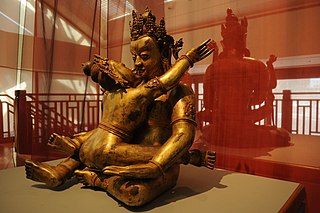
Tantric sex or sexual yoga refers to a range of practices in Hindu and Buddhist tantra that utilize sexuality in a ritual or yogic context. Tantric sex is associated with antinomian or elements such as the consumption of alcohol, and the offerings of substances like meat to deities. Moreover, sexual fluids may be viewed as power substances and used for ritual purposes, either externally or internally.
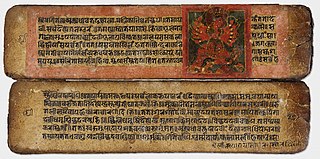
Sanskrit literature broadly comprises all literature in the Sanskrit language. This includes texts composed in the earliest attested descendant of the Proto-Indo-Aryan language known as Vedic Sanskrit, texts in Classical Sanskrit as well as some mixed and non-standard forms of Sanskrit. Literature in the older language begins with the composition of the Ṛg·veda between about 1500 and 1000 BCE, followed by other Vedic works right up to the time of the grammarian Pāṇini around 6th or 4th century BCE.

Sādhanā is an ego-transcending spiritual practice. It includes a variety of disciplines in Hindu, Buddhist and Jain traditions that are followed in order to achieve various spiritual or ritual objectives.
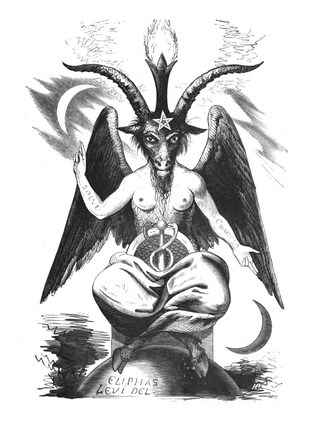
In Western esotericism, left-hand path and right-hand path are two opposing approaches to magic. This terminology is used by various groups involved in the occult and ceremonial magic. In some definitions, the left-hand path is equated with malicious black magic, while the right-hand path is equated with benevolent white magic. Other occultists have criticised this definition, believing that the left–right dichotomy refers merely to different kinds of working and does not necessarily connote good or bad magical actions. Other practitioners state the difference between the two is that the desired outcome of the right is to be beside God and to serve him, while the left believe in self-deification and bow to no one.

Nath, also called Natha, are a Shaiva sub-tradition within Hinduism in India and Nepal. A medieval movement, it combined ideas from Buddhism, Shaivism and Yoga traditions of the Indian subcontinent. The Naths have been a confederation of devotees who consider Shiva as their first lord or guru, with varying lists of additional gurus. Of these, the 9th or 10th century Matsyendranatha and the ideas and organization mainly developed by Gorakhnath are particularly important. Gorakhnath is considered the originator of the Nath Panth.
Dakṣiṇā or Dakshina is a Sanskrit word found in Buddhist, Hindu, Sikh and Jain literature where it may mean any donation, fees or honorarium given to a cause, monastery, temple, spiritual guide or after a ritual. It may be expected, or a tradition or voluntary form of dāna. The term is found in this context in the Vedic literature.
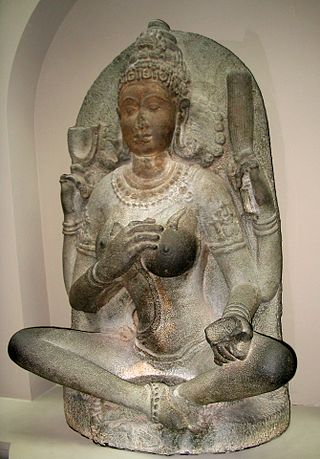
A yogini is a female master practitioner of tantra and yoga, as well as a formal term of respect for female Hindu or Buddhist spiritual teachers in Indian subcontinent, Southeast Asia and Greater Tibet. The term is the feminine Sanskrit word of the masculine yogi, while the term "yogin" IPA:[ˈjoːɡɪn] is used in neutral, masculine or feminine sense.
Neotantra, navatantra, or tantric sexuality, is a Western new religious movement influenced by the Eastern esoteric spiritual traditions of Tantra. Rooted in elements of Hindu and Buddhist tantras, neotantra blends New Age interpretations with modern Western perspectives, often emphasizing the sexual aspects of these ancient traditions. While some proponents reference traditional texts and principles, many utilize tantra as a broader term encompassing sacred sexuality, occasionally incorporating unconventional practices. However, neotantra does not always adhere to the complete range of Indian tantric practices, particularly the reliance on a guru.

Panchamakara or Panchatattva, also known as the Five Ms, is the Tantric term for the five substances used in a Tantric practice. These are madya (alcohol), māṃsa (meat), matsya (fish), mudrā (grain), and maithuna. Taboo-breaking elements are only practiced literally by "left-hand path" tantrics (vāmācārins), whereas "right-hand path" tantrics (dakṣiṇācārins) oppose these.
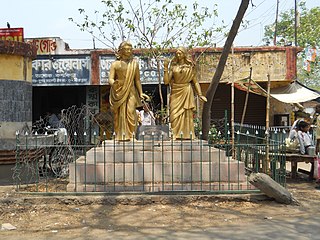
Vaiṣṇava Sahajiyā was a form of Hindu tantric Vaishnavism focused on Radha Krishna worship that developed in Eastern India. This tradition flourished from the 16th to the 19th century. The Vaiṣṇava Sahajiyā tradition produced many great poets who wrote in the Bengali language, the most famous of these poets all wrote under the pen name Chandidas. Their religious literature was mainly written in Bengali vernacular.
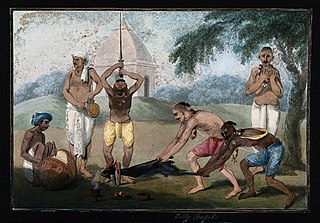
Vāmācāra is a tantric term meaning "left-hand path" and is synonymous with the Sanskrit term vāmamārga. It is used to describe a particular mode of worship or sadhana that is not only heterodox to standard Vedic injunction, but extreme in comparison to the status quo.
The roots of Shaktism – a Hindu denomination that focuses worship upon Shakti or Devi, the Hindu Divine Mother – penetrate deeply into India's prehistory. The Devi's earliest known appearance in Indian Paleolithic settlements is believed to go back more than 8000 years ago. The Badrinath Monastery, dated to about 7000 years ago, and its associated ritual site of Adi Shankara have been well studied.
Dakṣiṇa (दक्षिण), Sanskrit for "right-hand side", may refer to:

Batuka Bhairava or Vatuka Bhairava is a fierce form of Shiva in Hindu iconography, associated with his manifestation of Bhairava. This form of Shiva is depicted as a fierce, nude youth, usually accompanied with a dog in the Tantric tradition.

Sādhana is an ego-transcending spiritual practice. It includes a variety of disciplines from any culture like Hindu, Buddhist, Jain and Sikh traditions that are followed in order to achieve various spiritual or ritual objectives.

The Karma Yoga is the third of the eighteen chapters of the Bhagavad Gita. The chapter has a total of 43 shlokas. The chapter is the 25th chapter of Bhishma Parva, the sixth book of the Mahabharata.














